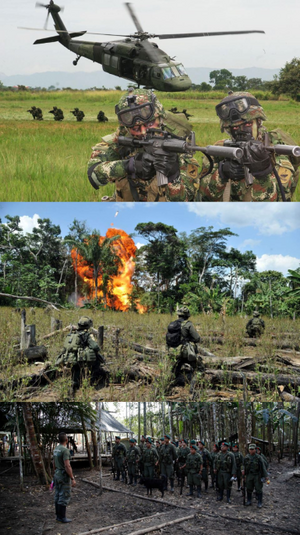Caranad Conflict
| Caranad Conflict (1965-Present) | |||||||
|---|---|---|---|---|---|---|---|
 Top: Caranadian soldiers in the combat zone Center: Caranadian soldiers detonate a weapons cache Bottom: UPDA rebels stand in formation | |||||||
| |||||||
| Belligerents | |||||||
|
Supported by: | UPDA | ||||||
| Commanders and leaders | |||||||
|
|
Juan Manuel Graciani Mario Arboleda Juan Andrés Aguinaldo Ramón Cambeiro Santino Velázquez | ||||||
| Strength | |||||||
|
National police: 145,602 Army: 259,587 Air Force: 16,082 | UPDA: 13,972 (2015) | ||||||
| Casualties and losses | |||||||
| lots | |||||||
Armed conflict
Background
Caranad civil war
Belroux massacre
Timeline
1960s
1970s
1980s
1990s
2000 - 2009
2010 - Present
Role of foreign states
Aquitayne
Aswick
Aswick currently has several units in Caranad. They operate mainly from Camp Bastion in the northern province of Cardina, some 150 miles North-East of the Coalition's main base of San Romero. As of December of 2017, 4th Battalion Royal Fusiliers handed over responsibility to 33 Commando Royal Marines.
In addition to Camp Bastion, the Aswickan Forces have built and hold a total of three Forward Operating Bases. FOB Andersen named after Roy Andersen, a Captain in the Army killed by a roadside I.E.D near the FOB's location. FOB Gopnic named after Lance-Corporal Alan Gopnic, brutally killed and mutilated after he was captured by insurrectionist forces. Lastly there is FOB Kolniczynki named after Private Kolniczynki, who was killed after the Aquitaynian helicopter he was being CASEVACed by crashed due to faulty maintenance.
Among the troops stationed there are detachments from all four branches of His Majesty's Armed Forces.